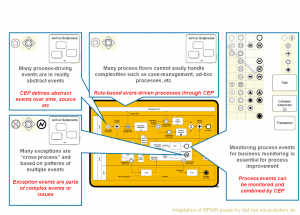There has been a whole bunchload of speculation and hype following the latter of the 2 BPM vendor takeovers at the end of 2009 – especially as the vendor concerned (Progress Software) is also a CEP vendor (through acquisition Apama).
Firstly – congratulations to Progress and new CTO / ex-CEP-supremo John Bates for getting into the BPM business!
Secondly – of course there are synergies between the worlds of BPM and CEP. Both are doing stateful event processing. BPM focusses on the business process viewpoint (and is most suitable where business processes appear as sequential flows, like workflows and managing human-oriented processes). CEP focusses on the event viewpoint, and the patterns and processing that needs to be carried out on that event.
Typically, CEP is used with BPM (or vice versa, depending on your perspective!) in a number of ways. In order of popularity:
- complex events used to trigger business processes (such as fraud event invoking fraud handling workflow)
- monitoring business processes (state changes etc) and thence process performance
- complex / dynamic process management to support workflows (CEP controlling BPM, event- and rule-driven BPM, etc)
- delegation of event processing in BPM to CEP for exception handling and other complex event handling scenarios.
In a some cases, organisations have been known to model their entire business processes as events, states and rules – effectively bypassing the process viewpoint – and implementing workflows directly in a CEP environment like TIBCO BusinessEvents. This is not as daft as it may first seem: indeed BusinessEvents can generate a similar view as an output (in the “Rule Analyzer”).
Meanwhile, we look forward to TIBCO getting some competition for these CEP-BPM patterns (and any more they find, of course)!





